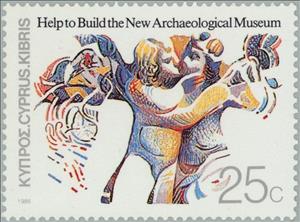Stamp: Clay cluster of Cupid and Psyche, Roman Period 50 B.C. - 400 (Cyprus 1986)
Clay cluster of Cupid and Psyche, Roman Period 50 B.C. - 400 (Cyprus 1986)
17 February (Cyprus ) within release Archeologic Museum goes into circulation Stamp Clay cluster of Cupid and Psyche, Roman Period 50 B.C. - 400 face value 25 Cypriot cent
| Stamp Clay cluster of Cupid and Psyche, Roman Period 50 B.C. - 400 in catalogues | |
|---|---|
| Michel: | Mi:CY 653 |
Stamp is horizontal format.
Also in the issue Archeologic Museum:
- Stamp - Alabaster spoon handle, Hellenistic Period 350-325 B.C. face value 15;
- Stamp - Early Ionian Pillar, Archaic Period 750-475 B.C. face value 20;
- Stamp - Clay cluster of Cupid and Psyche, Roman Period 50 B.C. - 400 face value 25;
- Stamp - Athlete's head with wreath, Classic Period 475-325 B.C. face value 30;
- Souvenir Sheet - Artist's Impression of Archaeological Artifacts face value 1;
Stamp Clay cluster of Cupid and Psyche, Roman Period 50 B.C. - 400 it reflects the thematic directions:
A museum (/mjuːˈziːəm/ mew-ZEE-əm) is an institution dedicated to displaying and/or preserving culturally or scientifically significant objects. Many museums have exhibitions of these objects on public display, and some have private collections that are used by researchers and specialists. Compared to a library, a museum hosts a much wider range of objects and usually focus around a specific theme such as the arts, science, natural history, local history, and other topics. Public museums that host exhibitions and interactive demonstrations are often considered to be tourist attractions, and many museums attract large numbers of visitors from outside their host country, with the most visited museums in the world regularly attracting millions of visitors annually.
Archaeology or archeology[a] is the study of human activity through the recovery and analysis of material culture. The archaeological record consists of artifacts, architecture, biofacts or ecofacts, sites, and cultural landscapes. Archaeology can be considered both a social science and a branch of the humanities. It is usually considered an independent academic discipline, but may also be classified as part of anthropology (in North America – the four-field approach), history or geography


